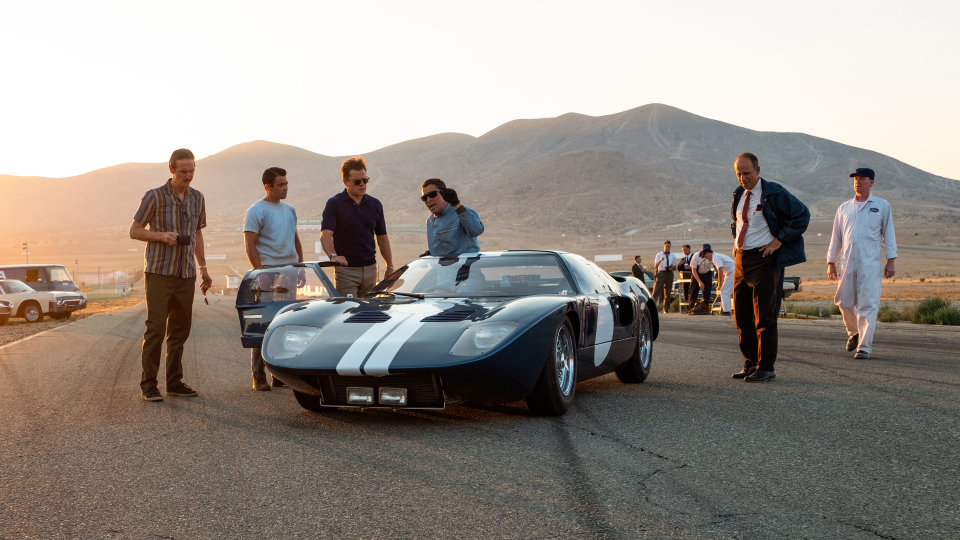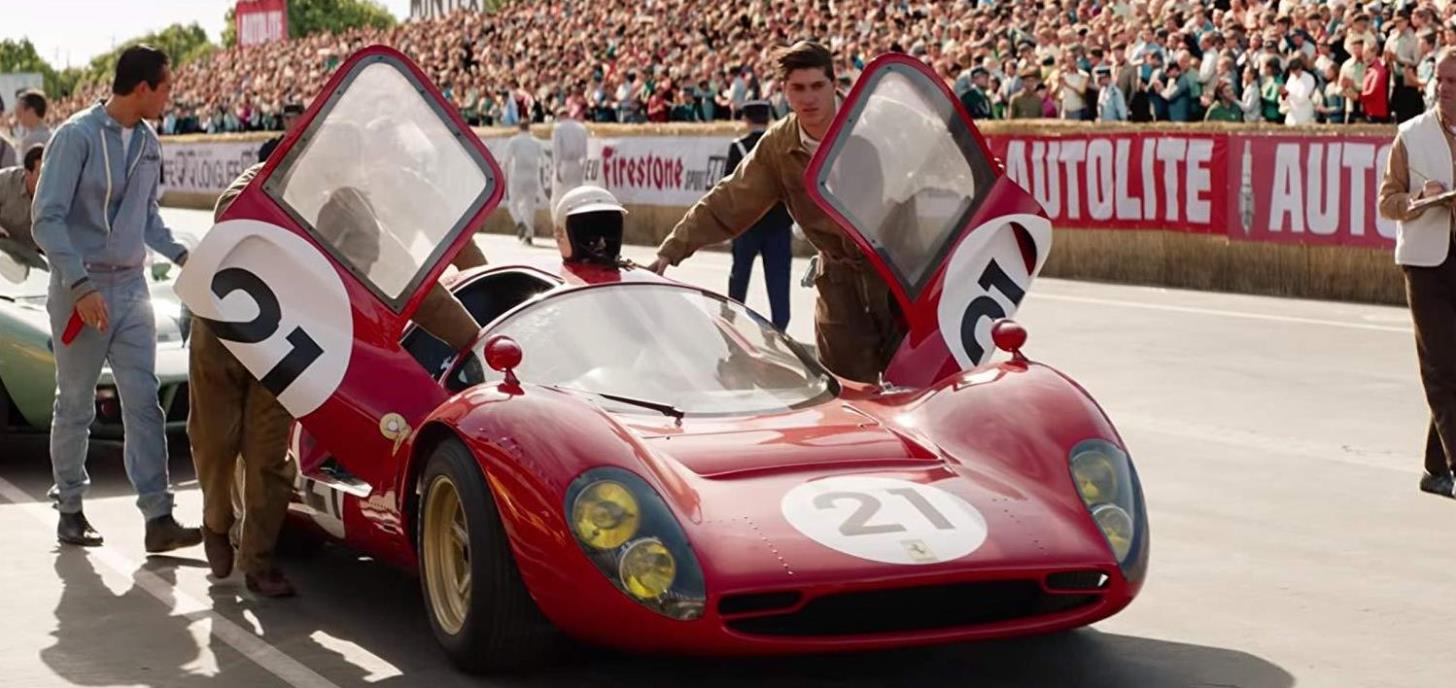Talented actors bring a certain physicality to their roles, one that establishes the character and yet, when done well, does not call attention to itself. I’m not talking about a showy distraction like Jake Gyllenhaal constantly blinking in Prisoners. I’m talking Christian Bale in Ford v. Ferrari, as real-life race car driver Ken Miles, who has what can only be described as a kind of squirrely aspect to him. He walks with a sort of permanent stagger, not like that of a man drunk, but of a man who is constantly falling out of line and catching himself – an apt description for a rebel like Miles. He’s got a bemused grin perennially plastered to his face, and he’s got kind of a conspiratorial hunch to his shoulders, like he’s working on some kind of scheme.
In a way, he is. Miles is one of a number of collaborators trying to stick it to the pompous geniuses at Ferrari, who are impossible to beat at the French 24-hour race Le Mans, and who have just rejected a generous offer to buy their company from the Ford Motor Company. It’s not that they rejected the offer, but the way Enzo Ferrari called the Ford executives sons of whores, that really gets the goat of Henry Ford II (Tracy Letts). In a fit of pride and vengeance, Ford the younger declares that his company will build a car that can beat Ferrari at this year’s Le Mans. Or more accurately, “bury Ferrari 100 deep under the finish line,” a bit of enraged spittle forming at the corners of his mouth.
Enter Miles, but first, enter retired driver Carroll Shelby (Matt Damon), who became the head of race car manufacturer Shelby American after his heart condition forced him out of racing. Working within the unlimited financial resources, but also the considerable design and engineering constraints, of a company that churns out sturdy family vehicles, Shelby sets out to do the impossible: design this world beater of a race car in only 90 days. Miles virtually laughs him out of the coffee shop when Shelby approaches him about being his driver, but Miles has also gone broke, which is not a good look when you’re supporting a wife and young son.
Body language is not the only way Bale has developed this character. In addition to a hot temper and, shall we say, a healthy skepticism of most things, Miles is also a bit of a loon, as he shouts and sings to himself as he encircles test tracks at increasingly ridiculous speeds. Able to use what amounts to his regular speaking voice for one of the very rare times in his career, Bale feels free to fully inhabit Ken Miles, and inhabit he does.
If I’ve gone on at length about Christian Bale, it’s only as an example of something Ford v. Ferrari gets right at every turn – so to speak. It’s the specificity. This is a movie that takes place in 1966 and absolutely feels like it, but it also lives and moves around in 1966 until it’s completely at home and comfortable. This is a sports movie and a procedural and a couple other fun genres – buddy comedy might even be one, with the rapport Miles and Shelby, or Bale and Damon, have with one another. Its 152 minutes allows it to establish itself in multiple ways, from the development of the characters to the fullness of its setting.
Part of that fullness is the way director James Mangold fills his screen with images. He sets the camera up so that its subjects seem larger than life, but not in some cheap, Michael Bay way. He’s just using his tools to give us an engrossing viewing experience, where images pop, collide and disappear into the distance in a whir of engine parts. Certainly part of what’s so dynamic about the film’s look is the way Mangold’s regular cinematographer, Phedon Papamichael, has continued to expand the art of filming objects moving at high speeds. The race sequences here are thrilling, to use a word that’s too ordinary by half to really describe them. They are propelled by a sound design to match Miles’ wife’s description of the reverberating sensation of an engine operating at high speeds. She explains that the sound “tears right through you,” and so does this movie’s approximation thereof.
Mangold has sneakily graduated from competent technician to minor master in his area of expertise. When he first came on the scene, he was little more than a glorified director for hire, but with Logan and now this unqualified success, he’s established himself as someone to really take seriously. Perhaps working with Bale in 3:10 to Yuma helped extract this performance from him, but perhaps more impressive is Mangold’s command of a story that has deceptively large size and scope.
It’s no mere tale of barracking for the underdog, either. In very few interpretations of reality could one of the world’s largest and most enduring car manufacturers be considered an underdog, as one Ford executive notes that the company spends more on toilet paper in a year than Ferrari spends on its whole operation. What’s more, few of the Ford leadership team really come across as sympathetic. One suit played by Josh Lucas fills the villain role, and is one of the film’s only really broad elements. Ford himself is less a visionary than a cranky autocrat trying to step out of his deceased father’s shadow. Only Jon Bernthal’s Lee Iacocca really comes off as a man with a commendable moral compass.
That’s where Miles and Shelby come in. They are both men wrestling their own demons, who are allowed, for a moment, to shrug off those demons and shine. All involved, on both sides of the “v,” are Goliaths in some respect, as they are at the very tops of their fields. But these two are in touch with their inner Davids, and therefore, so are we.


